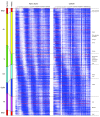High-resolution transcription atlas of the mitotic cell cycle in budding yeast
- PMID: 20193063
- PMCID: PMC2864564
- DOI: 10.1186/gb-2010-11-3-r24
High-resolution transcription atlas of the mitotic cell cycle in budding yeast
Abstract
Background: Extensive transcription of non-coding RNAs has been detected in eukaryotic genomes and is thought to constitute an additional layer in the regulation of gene expression. Despite this role, their transcription through the cell cycle has not been studied; genome-wide approaches have only focused on protein-coding genes. To explore the complex transcriptome architecture underlying the budding yeast cell cycle, we used 8 bp tiling arrays to generate a 5 minute-resolution, strand-specific expression atlas of the whole genome.
Results: We discovered 523 antisense transcripts, of which 80 cycle or are located opposite periodically expressed mRNAs, 135 unannotated intergenic non-coding RNAs, of which 11 cycle, and 109 cell-cycle-regulated protein-coding genes that had not previously been shown to cycle. We detected periodic expression coupling of sense and antisense transcript pairs, including antisense transcripts opposite of key cell-cycle regulators, like FAR1 and TAF2.
Conclusions: Our dataset presents the most comprehensive resource to date on gene expression during the budding yeast cell cycle. It reveals periodic expression of both protein-coding and non-coding RNA and profiles the expression of non-annotated RNAs throughout the cell cycle for the first time. This data enables hypothesis-driven mechanistic studies concerning the functions of non-coding RNAs.
Figures




Similar articles
-
XUTs are a class of Xrn1-sensitive antisense regulatory non-coding RNA in yeast.Nature. 2011 Jun 22;475(7354):114-7. doi: 10.1038/nature10118. Nature. 2011. PMID: 21697827
-
Bidirectional promoters generate pervasive transcription in yeast.Nature. 2009 Feb 19;457(7232):1033-7. doi: 10.1038/nature07728. Epub 2009 Jan 25. Nature. 2009. PMID: 19169243 Free PMC article.
-
Transcriptome analysis of smut fungi reveals widespread intergenic transcription and conserved antisense transcript expression.BMC Genomics. 2017 May 2;18(1):340. doi: 10.1186/s12864-017-3720-8. BMC Genomics. 2017. PMID: 28464849 Free PMC article.
-
Pervasive transcription - Lessons from yeast.Biochimie. 2011 Nov;93(11):1889-96. doi: 10.1016/j.biochi.2011.07.001. Epub 2011 Jul 12. Biochimie. 2011. PMID: 21771634 Review.
-
Unexpected complexity of the budding yeast transcriptome.IUBMB Life. 2008 Dec;60(12):775-81. doi: 10.1002/iub.121. IUBMB Life. 2008. PMID: 18649367 Review.
Cited by
-
Inferring orthologous gene regulatory networks using interspecies data fusion.Bioinformatics. 2015 Jun 15;31(12):i97-105. doi: 10.1093/bioinformatics/btv267. Bioinformatics. 2015. PMID: 26072515 Free PMC article.
-
The conserved histone deacetylase Rpd3 and its DNA binding subunit Ume6 control dynamic transcript architecture during mitotic growth and meiotic development.Nucleic Acids Res. 2015 Jan;43(1):115-28. doi: 10.1093/nar/gku1185. Epub 2014 Dec 3. Nucleic Acids Res. 2015. PMID: 25477386 Free PMC article.
-
Reconciling conflicting models for global control of cell-cycle transcription.Cell Cycle. 2017 Oct 18;16(20):1965-1978. doi: 10.1080/15384101.2017.1367073. Epub 2017 Sep 21. Cell Cycle. 2017. PMID: 28934013 Free PMC article.
-
Consensus clustering for Bayesian mixture models.BMC Bioinformatics. 2022 Jul 21;23(1):290. doi: 10.1186/s12859-022-04830-8. BMC Bioinformatics. 2022. PMID: 35864476 Free PMC article.
-
Bck2 acts through the MADS box protein Mcm1 to activate cell-cycle-regulated genes in budding yeast.PLoS Genet. 2013 May;9(5):e1003507. doi: 10.1371/journal.pgen.1003507. Epub 2013 May 9. PLoS Genet. 2013. PMID: 23675312 Free PMC article.
References
-
- Kampa D, Cheng J, Kapranov P, Yamanaka M, Brubaker S, Cawley S, Drenkow J, Piccolboni A, Bekiranov S, Helt G, Tammana H, Gingeras TR. Novel RNAs identified from an in-depth analysis of the transcriptome of human chromosomes 21 and 22. Genome Res. 2004;14:331–342. doi: 10.1101/gr.2094104. - DOI - PMC - PubMed
-
- Kapranov P, Cheng J, Dike S, Nix DA, Duttagupta R, Willingham AT, Stadler PF, Hertel J, Hackermuller J, Hofacker IL, Bell I, Cheung E, Drenkow J, Dumais E, Patel S, Helt G, Ganesh M, Ghosh S, Piccolboni A, Sementchenko V, Tammana H, Gingeras TR. RNA maps reveal new RNA classes and a possible function for pervasive transcription. Science. 2007;316:1484–1488. doi: 10.1126/science.1138341. - DOI - PubMed
-
- Schadt EE, Edwards SW, GuhaThakurta D, Holder D, Ying L, Svetnik V, Leonardson A, Hart KW, Russell A, Li G, Cavet G, Castle J, McDonagh P, Kan Z, Chen R, Kasarskis A, Margarint M, Caceres RM, Johnson JM, Armour CD, Garrett-Engele PW, Tsinoremas NF, Shoemaker DD. A comprehensive transcript index of the human genome generated using microarrays and computational approaches. Genome Biol. 2004;5:R73. doi: 10.1186/gb-2004-5-10-r73. - DOI - PMC - PubMed
-
- Yelin R, Dahary D, Sorek R, Levanon EY, Goldstein O, Shoshan A, Diber A, Biton S, Tamir Y, Khosravi R, Nemzer S, Pinner E, Walach S, Bernstein J, Savitsky K, Rotman G. Widespread occurrence of antisense transcription in the human genome. Nat Biotechnol. 2003;21:379–386. doi: 10.1038/nbt808. - DOI - PubMed
Publication types
MeSH terms
Substances
LinkOut - more resources
Full Text Sources
Other Literature Sources
Molecular Biology Databases

